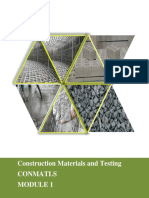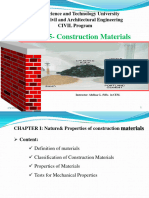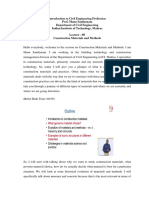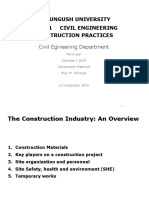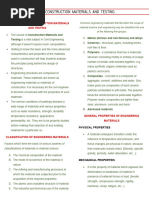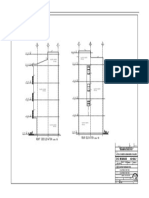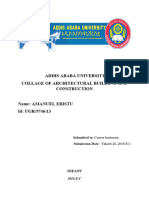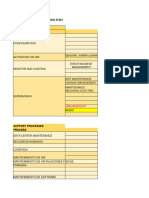0 ratings0% found this document useful (0 votes)
2 viewslecture1
Uploaded by
Amanuel EristuCopyright
© © All Rights Reserved
Available Formats
Download as PDF, TXT or read online on Scribd
0 ratings0% found this document useful (0 votes)
2 viewslecture1
Uploaded by
Amanuel EristuCopyright
© © All Rights Reserved
Available Formats
Download as PDF, TXT or read online on Scribd
You are on page 1/ 14
CHAPTER ONE
Introduction
Generals
There are many different materials
used in the building industry.
Watch around and observe what you
see in the surrounding:
• Walls made of HCB
• Columns and beams made of steel
and concrete
• Paint
• Wooden door
• Metal windows
Introduction
Generals
Material found naturally are
called “Natural building
materials”
Produced in the factories
are called “Artificial building
materials”.
Should be well studied
To produce safe and economical
construction
Introduction
Definition Of Terms
Construction Materials: any material used
in construction industry.
Building Materials: Materials that are used
in the building industry
Cementitious materials: -Portland cement
or another type of hydraulic cements
Ceramic Materials: materials based on clay
(silicate mineral)
• crystalline and brittle,
• do not conduct electricity very well, and
• can withstand high temperatures.
Introduction
Definition Of Terms
Crystalline materials: atoms repeat pattern in
3D dimensions.
Thermoplastic Materials: turn plastic (soft)
when subjected to heat.
Ductile Materials: to be drawn out or
stretched to a considerable extent before
rupture.
Measured as the percentage of elongation (increase in
length) or as the percentage of the reduction in the cross-
sectional area, when the material is subjected to tension.
Examples :steel ,aluminum etc.
Introduction
Definition Of Terms
Elastic Materials: deform under load without a
permanent set or deformation up on release
of the load.
A perfectly elastic material – retains original
shape and dimensions when loads are removed.
None of the materials remain perfectly elastic
throughout the range of stress leading up to
failure.
But all exhibit elastic properties up to some
stress level.
An elastic material behaves in elastically when
the stress exceeds the elastic limit, beyond
which changes in volume, shape are permanent.
Introduction
Nature of Materials
• The nature of the material is so
scattered that no one can predict
without reliable knowledge as to how
the materials respond when they are
exposed to some actual working
conditions: such as;
• firing effects,
• damping effects, and
• loading conditions.
Introduction
Choice of Construction Materials
• Modern structures often comprise vast
number of components.
• Pre-manufactured & assembled on site
• Manufactured at a construction site
• In each case satisfactory operation of
the building as a whole depends on
• Performance of the materials from which its
components are made
• How they interact with each other in the
structure.
Introduction
Consideration in Choosing Construction Materials
• AVAILABILITY
• Is the material produced locally, or is it partially or entirely imported?
• Can the material and technology be used and understood by the local workers, or are
special skills and experience required?
• Are repairs and replacements possible with local means?
• ECONOMICAL
• Is it cheap, abundantly available, and/or easily renewable?
• Has it been produced in a factory far away (transportation costs!);
• Does it require special machines and equipment, or can it be produced at lower cost on
the building site?
• ENVIRONMENTAL
• Does its production and use require a high-energy input, and cause wastage and
pollution? Is there an acceptable alternative material which eliminates these problems?
• SAFETY
• Is the material and construction technique climatically acceptable?
• Does the material and construction technique provide sufficient safety against common
natural hazards (e.g. fire, biological agents, heavy rain, and earthquakes)?
• SOCIAL ACCEPTANCE
• Is the material socially acceptable? Is it considered low standard, or does it offend
religious belief? Does it match with the materials and constructions of nearby buildings?
Introduction
Choice of Construction Materials
What is that you specifically need from the material?
• color,
• shape,
• texture,
• size,
• strength,
• Answering this question will directly lead you to the exact
requirements that you have to apply on the material.
What defects make the material fail?
• overloading,
• extra heat,
• collision,
• age,
• abrasion,
• Answering this question will tell you how you can handle the
materials properly and make their use economical.
Introduction
Requirements
An ideal construction material shall be tested for the
following requirements:
1.Strength: This refers to the materials resistance against
forces or loads.
Compressive strength: The material’s resistance against
compressive loading.
Tensile strength: The material’s resistance against tensile
loading.
Flexural strength: The material’s resistance against
bending moment.
Shear strength: The material’s resistance against shearing
effects.
Torsion strength: The material’s resistance against twisting
loads.
Introduction
Requirements
2.Durability: The longer a material stays giving service; the more it
looses its strength. A material is said to be ‘durable’ if it scores greater
ages under service without failure.
3.Fire Resistance: This does not mean an absolute fire proof.
However, a material can be made fire resistant that it does not burn just
by simple firing effects.
4.Water proofing: A material should be, in most cases, be water
proof as water /moisture/ will affect the molecular /particular/ bond with in
the materials. The requirement becomes more important when the
material is to be exposed for high moisture.
5.Others: These usually take human psychology in to consideration:
color, shape, texture, and size are some of the requirements.
Among these color is identified as the highly influential on human
beings. Dark and heavy black colors have negative influence on
human beings, while White and bright colors create ease.
Introduction
Requirements
Note: Though cost of a material is one factor
that is taken in to consideration when selecting a
material, it should not be as such a detrimental
factor as cheaper materials may result in weak
performance on work.
Questions
You might also like
- Verbeke Chapter 1 Conceptual Foundations of International Business StrategyNo ratings yetVerbeke Chapter 1 Conceptual Foundations of International Business Strategy8 pages
- BS en 12150 - 1 2015 Thermally ToughenedNo ratings yetBS en 12150 - 1 2015 Thermally Toughened42 pages
- Week 1. Lecture_Introduction to Construction Materials(1)No ratings yetWeek 1. Lecture_Introduction to Construction Materials(1)53 pages
- CE 221 Materials Science: Assist. Prof - Dr. Hanifi BINICINo ratings yetCE 221 Materials Science: Assist. Prof - Dr. Hanifi BINICI21 pages
- Chapter 1 Lecture Nature& Properties of Construction MaterialsNo ratings yetChapter 1 Lecture Nature& Properties of Construction Materials46 pages
- 01 Introduction To Materials and TestingNo ratings yet01 Introduction To Materials and Testing32 pages
- CONMAT - PRELIM REVIEWER With More Sandamakmak Na InfoNo ratings yetCONMAT - PRELIM REVIEWER With More Sandamakmak Na Info13 pages
- L1-Introduction To Materials Engineering Concepts PDFNo ratings yetL1-Introduction To Materials Engineering Concepts PDF5 pages
- Chapter One Inroduction of Construction MaterialsNo ratings yetChapter One Inroduction of Construction Materials26 pages
- Chapter 1: Introduction: Construction Materials and TestingNo ratings yetChapter 1: Introduction: Construction Materials and Testing6 pages
- Introduction To Construction Materials and TestingNo ratings yetIntroduction To Construction Materials and Testing19 pages
- Introduction To Civil Engineering Material (1) 1No ratings yetIntroduction To Civil Engineering Material (1) 137 pages
- construction material 1 module CHAPTER 1No ratings yetconstruction material 1 module CHAPTER 113 pages
- LEC1 - Construction Materials and TestingNo ratings yetLEC1 - Construction Materials and Testing28 pages
- Describing of Materials of Construction Upload 2024No ratings yetDescribing of Materials of Construction Upload 202428 pages
- Building Material & Concrete Technology ENCE 234No ratings yetBuilding Material & Concrete Technology ENCE 23423 pages
- Lecture 1 Introduction To Construction Materials1No ratings yetLecture 1 Introduction To Construction Materials13 pages
- CONSTRUCTION MATERIALS AND TESTING1 SEC LectureNo ratings yetCONSTRUCTION MATERIALS AND TESTING1 SEC Lecture64 pages
- Lecture 1&2_791ec7ad-5b1f-4b5b-b46e-4e394973ba26No ratings yetLecture 1&2_791ec7ad-5b1f-4b5b-b46e-4e394973ba2643 pages
- President Ramon Magsaysay State University: College of Engineering/Department of Civil EngineeringNo ratings yetPresident Ramon Magsaysay State University: College of Engineering/Department of Civil Engineering116 pages
- MELE_FEB15 - Sheet - AR07 - SEVENTH FLOOR PLANNo ratings yetMELE_FEB15 - Sheet - AR07 - SEVENTH FLOOR PLAN1 page
- MELE_FEB15 - Sheet - AR09 - NORTH SOUTH (1)No ratings yetMELE_FEB15 - Sheet - AR09 - NORTH SOUTH (1)1 page
- Mele_feb15 - Sheet - Ar08 - Eighth Floor Plan (1)No ratings yetMele_feb15 - Sheet - Ar08 - Eighth Floor Plan (1)1 page
- Get Light and Vacuum The Wave Particle Nature of the Light and the Quantum Vacuum Electromagnetic Theory and Quantum Electrodynamics Beyond the Standard Model 2nd Edition Constantin Meis PDF ebook with Full Chapters Now100% (1)Get Light and Vacuum The Wave Particle Nature of the Light and the Quantum Vacuum Electromagnetic Theory and Quantum Electrodynamics Beyond the Standard Model 2nd Edition Constantin Meis PDF ebook with Full Chapters Now65 pages
- User Manual: Hgm9 810 Genset Parallel (With Genset) UnitNo ratings yetUser Manual: Hgm9 810 Genset Parallel (With Genset) Unit65 pages
- Strategic Human Resource Management: Mba Iv SemNo ratings yetStrategic Human Resource Management: Mba Iv Sem6 pages
- PDF Philosophy A Text with Readings 12th Edition Manuel Velasquez Solutions Manual download100% (5)PDF Philosophy A Text with Readings 12th Edition Manuel Velasquez Solutions Manual download48 pages
- Teaching Demonstration Rating Sheet FINAL 1No ratings yetTeaching Demonstration Rating Sheet FINAL 14 pages
- Deep Multimodal Representation Learning A SurveyNo ratings yetDeep Multimodal Representation Learning A Survey22 pages
- Genil - Yzabel - B - Activity - 2 - in - The - Contemporary - WorldNo ratings yetGenil - Yzabel - B - Activity - 2 - in - The - Contemporary - World2 pages
- BARANGAY HIZON FISH SANCTUARY Revised Management Plan (Draft) 2016-2021No ratings yetBARANGAY HIZON FISH SANCTUARY Revised Management Plan (Draft) 2016-202125 pages
- Banner Engineering - Glass Fiber Series - CatalogNo ratings yetBanner Engineering - Glass Fiber Series - Catalog43 pages
- Verbeke Chapter 1 Conceptual Foundations of International Business StrategyVerbeke Chapter 1 Conceptual Foundations of International Business Strategy
- Week 1. Lecture_Introduction to Construction Materials(1)Week 1. Lecture_Introduction to Construction Materials(1)
- CE 221 Materials Science: Assist. Prof - Dr. Hanifi BINICICE 221 Materials Science: Assist. Prof - Dr. Hanifi BINICI
- Chapter 1 Lecture Nature& Properties of Construction MaterialsChapter 1 Lecture Nature& Properties of Construction Materials
- CONMAT - PRELIM REVIEWER With More Sandamakmak Na InfoCONMAT - PRELIM REVIEWER With More Sandamakmak Na Info
- L1-Introduction To Materials Engineering Concepts PDFL1-Introduction To Materials Engineering Concepts PDF
- Chapter 1: Introduction: Construction Materials and TestingChapter 1: Introduction: Construction Materials and Testing
- Introduction To Construction Materials and TestingIntroduction To Construction Materials and Testing
- Describing of Materials of Construction Upload 2024Describing of Materials of Construction Upload 2024
- President Ramon Magsaysay State University: College of Engineering/Department of Civil EngineeringPresident Ramon Magsaysay State University: College of Engineering/Department of Civil Engineering
- Get Light and Vacuum The Wave Particle Nature of the Light and the Quantum Vacuum Electromagnetic Theory and Quantum Electrodynamics Beyond the Standard Model 2nd Edition Constantin Meis PDF ebook with Full Chapters NowGet Light and Vacuum The Wave Particle Nature of the Light and the Quantum Vacuum Electromagnetic Theory and Quantum Electrodynamics Beyond the Standard Model 2nd Edition Constantin Meis PDF ebook with Full Chapters Now
- User Manual: Hgm9 810 Genset Parallel (With Genset) UnitUser Manual: Hgm9 810 Genset Parallel (With Genset) Unit
- PDF Philosophy A Text with Readings 12th Edition Manuel Velasquez Solutions Manual downloadPDF Philosophy A Text with Readings 12th Edition Manuel Velasquez Solutions Manual download
- Genil - Yzabel - B - Activity - 2 - in - The - Contemporary - WorldGenil - Yzabel - B - Activity - 2 - in - The - Contemporary - World
- BARANGAY HIZON FISH SANCTUARY Revised Management Plan (Draft) 2016-2021BARANGAY HIZON FISH SANCTUARY Revised Management Plan (Draft) 2016-2021



